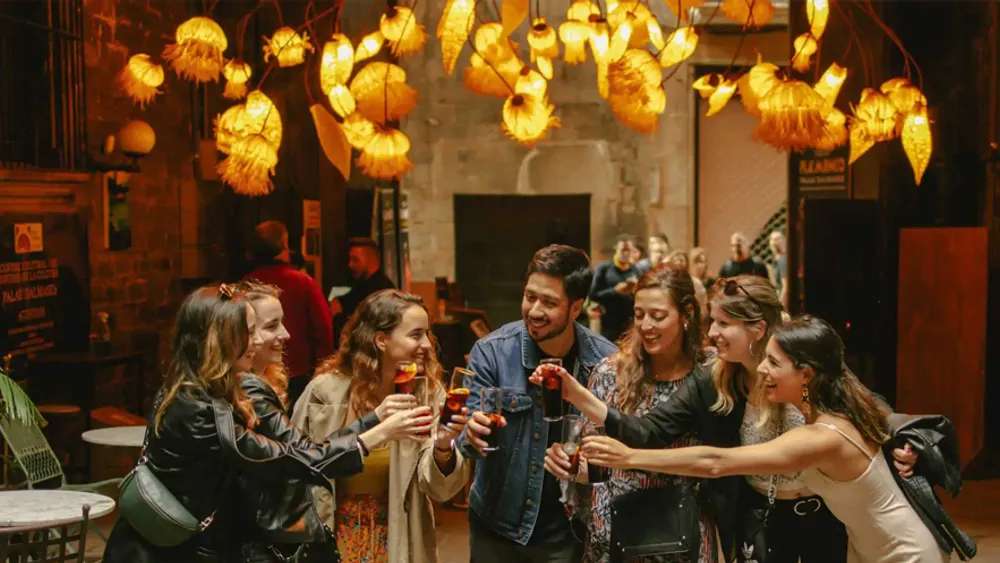Food and Drink Tours
Barcelona
Published: 28 Oct 2024
Catalonia, a region renowned for its vibrant culture, stunning landscapes, and of course, its delectable cuisine, is also home to a rich and diverse wine scene. From the sun-drenched vineyards of Penedès to the rugged terrain of Priorat, Catalan wines offer a unique expression of the land and its people.
In this article, we'll embark on a culinary journey through Catalonia, exploring the perfect pairings of local wines with traditional dishes. Get ready to tantalise your taste buds and discover the magic that happens when wine and food unite in perfect harmony.

The Barcelona Tipsy Tour
Understanding Catalan Wines
Catalonia's diverse terroir, ranging from coastal plains to mountainous regions, has given rise to a wide array of grape varieties and wine styles. This diversity is reflected in the unique characteristics of the wines produced, each offering distinct flavours and aromas that make them perfect partners for the region’s rich and varied cuisine. To fully appreciate the nuances of Catalan cuisine and wine pairings, it's essential to understand the different types of wines produced in the region.

The White Wines
Xarel·lo
Xarel·lo is one of the three traditional grape varieties used in the production of Cava, but it also stands out as a remarkable white wine on its own. Known for its crisp acidity and complex flavour profile, Xarel·lo wines often exhibit notes of green apple, pear, and citrus, along with subtle herbal and floral undertones. This makes Xarel·lo an excellent pairing with fresh seafood, such as grilled prawns or marinated anchovies, as well as light salads and vegetable dishes.
Garnacha Blanca
Garnacha Blanca, or White Grenache, is another prominent white grape variety in Catalonia. Wines made from Garnacha Blanca are typically fuller-bodied with a creamy texture and flavours of stone fruits, such as peach and apricot, complemented by hints of almond and a touch of minerality. These wines pair beautifully with richer seafood dishes, like creamy seafood stews or roasted fish with garlic and herbs. They also complement poultry dishes and creamy cheeses.

The Red Wines - Garnacha Tinta
Garnacha Tinta, or Red Grenache, is a versatile and widely planted red grape in Catalonia. Known for producing wines with high alcohol content and vibrant fruit flavours, Garnacha Tinta wines often showcase notes of red berries, such as strawberry and raspberry, along with spices like black pepper and hints of liquorice. These wines are perfect for pairing with grilled meats, hearty stews, and traditional Catalan dishes like botifarra (Catalan sausage) or escalivada (roasted vegetables).
Carinyena
Carinyena, also known as Carignan, is a robust red grape variety that thrives in Catalonia’s warm climate. Wines made from Carinyena are typically full-bodied with high tannins and acidity, offering flavours of dark fruits, such as blackcurrant and plum, alongside earthy and spicy notes. This powerful wine pairs well with rich and savoury dishes, such as braised lamb, game meats, and aged cheeses. Its bold character also makes it a great match for dishes with complex flavours, like Catalan-style roasted lamb with herbs and garlic.
Sparkling Wines - Cava
Cava is Catalonia’s renowned sparkling wine, made using the traditional method (the same method used for Champagne). Cava is typically produced from a blend of Xarel·lo, Macabeo, and Parellada grapes, resulting in a wine that is fresh and vibrant, with fine bubbles and flavours of green apple, citrus, and toasted brioche. Cava’s versatility makes it an excellent companion for a wide range of dishes, from light appetizers and tapas to rich main courses and desserts. It pairs particularly well with fried foods, such as calamari or croquettes, and can also complement creamy dishes like seafood paella or goat cheese salads.
Uncork the Flavors of Barcelona – Join a Wine Tour and Culinary Experience You’ll Never Forget!
Understanding the characteristics of Catalan wines is key to creating harmonious and delightful pairings with the region’s diverse cuisine. From the crisp and aromatic whites to the bold and complex reds, and the celebratory sparkle of Cava, each wine offers a unique experience that enhances the flavours of Catalan dishes. By exploring these pairings, you can truly appreciate the symbiotic relationship between Catalan wines and the local gastronomy, making every meal a memorable wine and dine experience.
The Art of Pairing
Pairing wine with food is an art form that elevates both the culinary and sensory experience, transforming a simple meal into a harmonious and delightful event. Understanding the fundamental principles of pairing can help you make the most of both the wine and the dish, ensuring that each enhances the other.
Here are some key concepts to consider:
Matching Weight and Intensity
One of the most important principles in wine pairing is matching the weight and intensity of the wine with the richness of the dish. Light wines, such as a crisp Xarel·lo or a delicate Garnacha Blanca, are best paired with lighter dishes like salads, seafood, or chicken. These wines have the finesse and subtlety to complement the dish without overwhelming it. Conversely, robust wines like Garnacha Tinta or Carinyena should be matched with hearty, flavourful dishes such as grilled meats, stews, and rich sauces. The intensity of the wine should mirror the intensity of the food, creating a balanced and satisfying pairing.
Complementary Flavours
Another effective approach is to pair wines with complementary flavours. For instance, a fruity Garnacha Tinta with notes of red berries can be a perfect match for a dish with sweet and tangy elements, such as a pork roast with a berry glaze. Similarly, a wine with herbal notes can complement dishes that feature similar herbs and spices. This principle helps to create a seamless transition between the flavours of the food and the wine, enhancing the overall dining experience.
Contrasting Textures
Pairing wines and foods with contrasting textures can also create exciting and memorable combinations. A sparkling wine like Cava, with its effervescence and bright acidity, can provide a refreshing contrast to the creamy texture of a cheese fondue or a rich seafood bisque. The bubbles and acidity help to cleanse the palate, preventing the richness of the dish from becoming overwhelming. Similarly, a tannic red wine can provide a pleasing contrast to the tender, juicy texture of a rare steak, adding complexity and depth to each bite.
Discover the Rich Tastes of Catalonia! Reserve Your Spot on a Barcelona Food & Wine Experience!
Acidity in Wine
Acidity in wine plays a crucial role in pairing, particularly with rich or fatty foods. High-acid wines, such as a zesty Xarel·lo or a bright Cava, can cut through the richness of fatty dishes, such as fried calamari, creamy cheeses, or a buttery seafood pasta. The acidity acts as a palate cleanser, refreshing your taste buds and making each bite as enjoyable as the first. This balancing act prevents the dish from feeling too heavy and enhances the flavours of both the wine and the food.
Tannins and Proteins
Tannins in red wine have a unique interaction with proteins in meat dishes. Tannins can bind with the proteins and fats in the meat, softening the perception of tannins and making the wine taste smoother and less astringent. This is why robust red wines like Garnacha Tinta and Carinyena are often paired with steak, lamb, or game meats. The tannins not only enhance the flavours of the meat but also create a more balanced and enjoyable drinking experience. The combination of tannins and proteins can elevate the dish, making the flavours more complex and satisfying.
Final Word
Mastering the art of wine pairing involves understanding these fundamental principles and experimenting with different combinations to discover what works best for your palate. By considering the weight and intensity of both the wine and the dish, exploring complementary flavours, and playing with contrasting textures, you can create pairings that elevate your dining experience.
The acidity and tannins in wine also play crucial roles in enhancing and balancing the flavours of your meal. Whether you’re enjoying a casual dinner at home or hosting a sophisticated dinner party, these principles will help you pair Catalan wines with local cuisine in a way that delights the senses and enriches the culinary journey.
Keep Exploring
Find more amazing tabl. experiences to visit.




